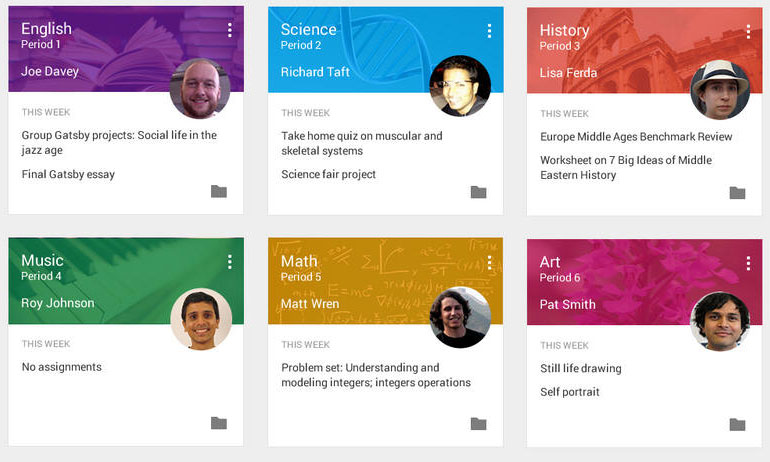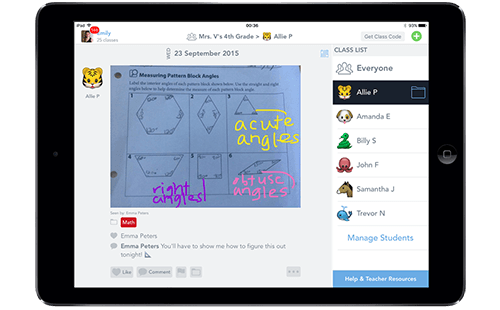Google Classroom

Google Classroom is an educational platform designed to support the creation, distribution, and grading of assignments in a paperless way. It goes hand in hand with other Google tools like Google Docs, Google Drive, and Gmail, offering a combined method for managing classroom activities. Students use Google Classroom to receive assignments, submit their work, and receive feedback from teachers. Teachers create and organize assignments, provide grades, and communicate with students and parents. Parents can stay informed about their child's progress and classroom activities. The platform promotes a collaborative learning environment where students can engage in discussions and group projects.

Google Classroom fosters efficient communication among students, teachers, and parents. Teachers can post announcements, provide feedback, and facilitate class discussions through the platform. Students can ask questions and collaborate with peers on assignments. The communication style is more formal within the platform, promoting an academic-focused interaction. Information is accessed and shared seamlessly through Google Classroom. Teachers can share resources, including videos, articles, and interactive content, directly with students. Students can also share their work and collaborate on projects in real-time. The platform ensures that all educational materials are readily accessible and organized.
Google Classroom positively impacts student learning and engagement by providing a structured environment for assignments and feedback. It encourages timely submission of work and continuous learning. However, it may also lead to challenges such as screen fatigue and the potential for reduced face-to-face interactions. Google Classroom is designed with robust privacy and safety features. Schools can manage user access and data security, ensuring that student information is protected. However, it is crucial to educate users about maintaining their own privacy and using the platform responsibly.
To navigate Google Classroom effectively, digital literacy is essential. Students, teachers, and parents need to understand how to use the platform’s features, manage digital files, and communicate appropriately online. Media literacy is also important to evaluate the quality and relevance of shared content. Google Classroom aligns well with educational goals by facilitating organized and accessible learning. Educators can leverage the platform to enhance instructional delivery and student engagement. Parents play a crucial role in monitoring their child's progress and supporting their learning journey. The platform’s ease of use and integration with other Google tools make it a valuable asset in modern education.
Seesaw

Seesaw is a student-driven digital portfolio that empowers students to document and reflect on their learning. It provides a platform for students to showcase their work, receive feedback, and engage with their learning community. Seesaw is widely used in K-12 education to support formative assessment and parent communication. Students use Seesaw to create and share digital portfolios that include photos, videos, drawings, and text notes. Teachers use the platform to give feedback, track student progress, and communicate with parents. Parents engage with Seesaw by viewing their child’s work and providing encouragement and support. Seesaw fosters a collaborative and interactive learning environment.
Seesaw enhances communication by allowing students to express their learning creatively and receive real-time feedback from teachers and parents. The communication style is more personalized and informal compared to traditional methods. It encourages students to take ownership of their learning and communicate their progress. Seesaw allows for diverse information consumption, including multimedia content and interactive activities. Students can access and review feedback, view their peers’ work, and reflect on their own progress. The platform supports a rich, multimedia learning experience that goes beyond traditional text-based learning.
Seesaw has a positive impact on student learning by encouraging active participation and self-reflection. It supports differentiated instruction and allows teachers to provide personalized feedback. However, it may also pose challenges such as managing screen time and ensuring equitable access to technology. Seesaw prioritizes student privacy and safety with secure login and data protection measures. Teachers and schools have control over user access and content sharing. Educating students and parents about online safety and responsible use is essential to maintaining a secure learning environment.
To effectively use Seesaw, digital literacy and visual literacy are crucial. Students, teachers, and parents need to navigate the platform, create and interpret multimedia content, and communicate effectively online. Reflective literacy is also important for students to engage in self-assessment and growth. Seesaw aligns with educational goals by promoting student engagement, personalized learning, and formative assessment. Educators can use the platform to support diverse learning styles and foster a reflective learning environment. Parents play a supportive role by actively engaging with their child’s learning journey and providing feedback. Seesaw’s focus on student-driven learning and creative expression makes it a valuable tool in modern education.
Image Addresses:
Hi Hannah! Thank you for sharing about Google Classroom and Seesaw. I use Google Classroom and I LOVE it, it is so user friendly and organized. I would like to evaluate parent / guardian proficiency on Google Classroom because they most likely have never used it before. My district doesn't use Seesaw, we use Rooms, but I think it would be a great addition. It's exciting that Seesaw extends beyond simply texts and it allows for pictures, videos, and other visual aids. I wonder if you could use gifs!
ReplyDeleteGreat post! I have never heard of seesaw before! I have to say I am very interested in it! I am especially impressed with the ability to for students to reflect on their learning. In my room students really do not get a chance to track their progress and see how they are progressing. I think this something I will be using in the future! Great job!
ReplyDeleteHannah,
ReplyDeleteThank you for the post. I enjoyed reading it.
Although Google Classroom is a inescapable platform now, I have never heard of Seesaw, and will most certainly determine whether it is a district-approved platform, and will incorporate it into my instruction.
You did an excellent and effective job in describing the platform and how it applied to digital literacy and student achievement.
Thank you, once again for the post!
- Corey
Hi Hannah!
ReplyDeleteThanks for your post.
My school is a Microsoft operating school- so Google Classroom isn't something I am very used to on the teacher's end. I wish my district used Google Classroom more- it seems much more user friendly than Microsoft Office and Teams, especially for elementary aged students.
I do use Seesaw every day at school. It is my FAVORITE app we have! Something I love to do on Seesaw is have an online reading log for when students independent read in the classroom. It helps them keep track of all the reading that they are doing throughout the school year but it also allows their parents to be actively involved in seeing what they are completing during the school day. I love when parents comment encouraging messages to their kids on their posts.
Great work!!